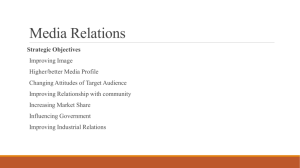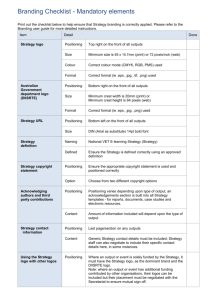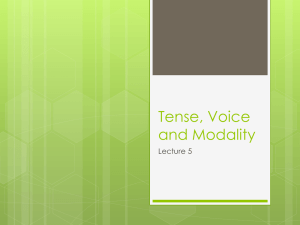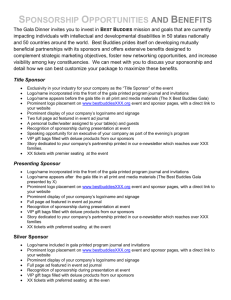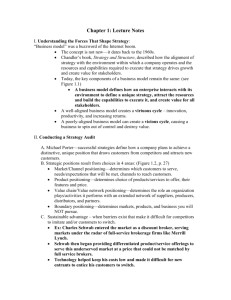Corporate Identity and Image
advertisement
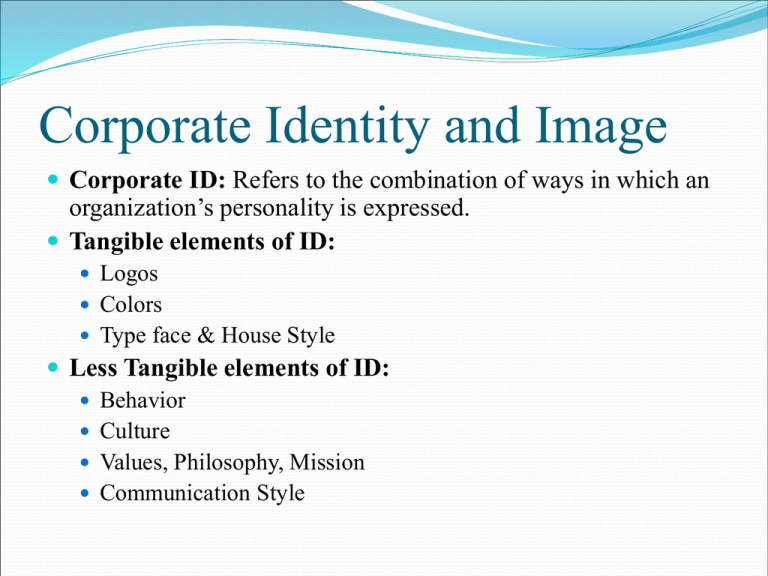
Corporate Identity and Image Corporate ID: Refers to the combination of ways in which an organization’s personality is expressed. Tangible elements of ID: Logos Colors Type face & House Style Less Tangible elements of ID: Behavior Culture Values, Philosophy, Mission Communication Style Corporate ID vs Corporate Image ID: is what organization communicates intentionally Image: Image is how its publics actually view it, An image is a perception and exists only in the minds of receiver ID>>>>>>>>Image To formulate an image, publics interpret ID in a wider context with frames of reference Benefits Public Profile and Recognition Better Customer Relations Brand Support Better Visual Representation Financial Advantages Express Culture and Values Staff Motivation Support for Communication Constructing Corporate Image Organizations can not construct a corporate image because they can not control the content in which their communication is received, interpreted and understood. Well-Managed Corporate Identity can go some way to effecting a strategically important image. Corporate Identity Mix Symbolism, Communication and Behavior Key Concepts of Corporate Identity Determining Organization’s actual identity and Desired Identity Audit the coherence between ID and Image Plan to adjust Corporate ID Corporate Strategy Corporate Identity Mix is a part of achieving overall organizational strategic objectives CI should be formulated in response to stakeholder needs and views should not be pre-determined Symbolism Using Cultural Codes and Associated Meaning Designers choose particular colors, shapes, typeface, graphics to evoke particular emotional response and to infer particular meanings Red Flag (Soviet Socialism) Red Rose (French Socialism) Examples The arrow points from A to Z showing how the company sells anything you'd ever want ... it also doubles as a smile. The V and the A in Sony's logo are meant to represent an analog sound wave, while the I and O stand for binary digits, evoking the digital age. With a clever use of negative space, the Pittsburgh Zoo pays homage to wide array of wildlife. Known for its 31 flavors, the company worked that element into its B and R logo. Types of Logos Monolithic: One Name, one Identity through out Endorsed: Parent company has different but prominent identity and brands have different/ prominent identities Branded: Parent company has a less prominent logo, brands are more prominent Monolithic: DELL, HP, MICROSOFT, APPLE Endorsed: Nestle Branded: P & G (Gillette, Olay, Oral-B, Dura-Cell, Ariel, Head & Shoulders, Pampers, Pentene, Wella, Vicks etc. P& G Consistency in Context of Communication and Behavior Principle of Consistency: Establishing consistent and sustainable internal images among all employees so positive cue can be communicated Organization should involve range of stakeholders in determining core philosophy and values and clearly communicate agreed goals How to bring consistency since different stakeholders have different needs and expectations? CSPs-Common starting points Reliability Profit-Making Innovation Synergy Quality Organic Process of communicating organizational images CSPs work function as parameters/ Communication guides Don’t limit staff to static agreed perceptions Sustainable Corporate Story Organization images should be consistent with CSPs Sustainable Corporate Story must have an effective framework Mission Vision Origins emotionally formulated core stories competencies fundamental beliefs values Corporate Culture Corporate Culture-Johnson & Scholes’s Cultural Web Understanding Culture as part of Corporate Identity Paradigm in Center Stories Symbols Power Structure Organizational Structures Control Systems Rituals and Routines Corporate personality is made up of organizations: Corporate Personality History Culture Belief Values Realized through staff, structures, products and services Example: GEO TV GEO Vision: "live and let live“ Human Resource: Diverse cultural backgrounds and multi-ethnic origins add up to create a strong resource base at GEO. Researching Corporate ID Identifying Desired Corporate Identity Audit Existing Corporate Identity Communication and Behavior audit Behavioral Survey Job Satisfaction Measuring effectiveness of internal policies Organization’s impact on stakeholders Communication climate: Communication style and content Visual ID Audit Logo Designs Decors Factories Showrooms Brochures Advertising instructional manuals Van Riel’s Model of CI Management Problem Analysis Current positioning Translation in to CI Mix External Image Research Competition Market Analysis Gap analysis Maintaining Current positioning Adjusting current positioning Determination of New Position
